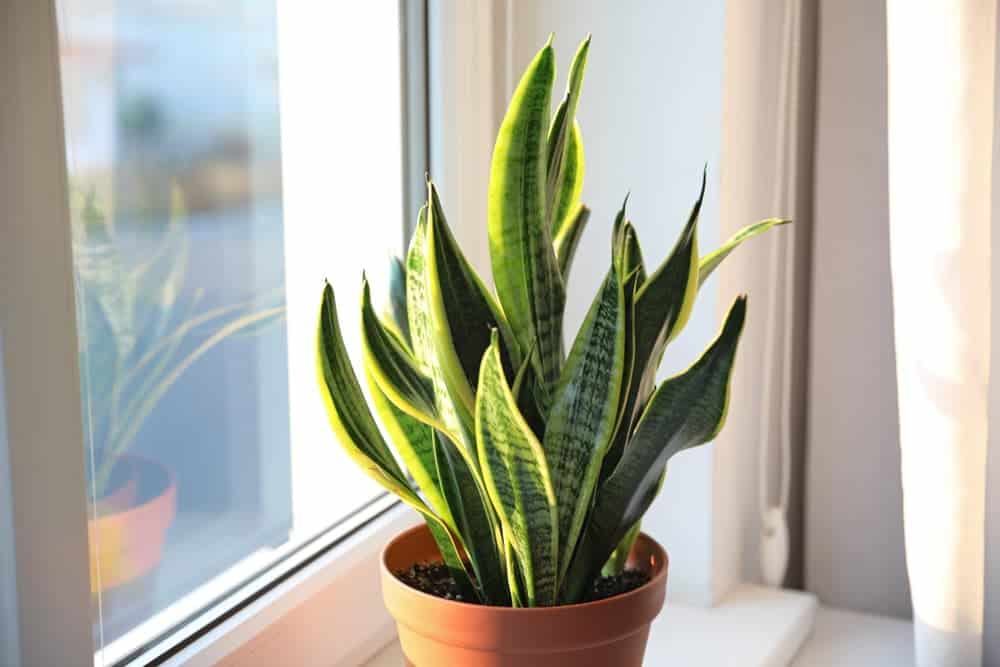The Sansevieria plant is also known as a Snake plant or Mother-in-law’s Tongue.
They’re noted for their extreme hardiness, and rarely are bothered by diseases or insect pests. When the leaves turn yellow, there is a problem with your plant so you need to figure it out before you lose your plant.
The Sansevieria Plant
The plant is native to the tropics of West Africa and is becoming a popular houseplant. It has near indestructible qualities but it can have its issues. The reason that this is becoming a popular house plant is due to its upright, erect leaf habit that will fit in with most décor. The spear-like leaves are multi-colored. It grows in indirect bright light and does not require a lot of water.
The long stiff leaves grow vertically from the soil and can reach between 28 and 35 inches. Most of them have dark green leaves with a bright yellow edge and a grayish pattern. This plant will help to filter toxins from the air like nitrogen oxide, formaldehyde, xylene, and benzene. It can grow in low light so it is a good plant for your bedroom. With the right light, and water conditions your plant can live for five to ten years.
Why Sansevieria Plants Gets Yellow Leaves
The plant can suffer from several conditions that yellow and curl the leaves.
1. Moisture
It is important that you provide your plant with the right soil moisture. Overwatering is the number one cause of yellow leaves. The plant does not need much water to survive and you will only need to water it when 50% of the soil is dry. The plant does not like its roots soaked because this can lead to root rot and can kill your plant. If you alternate between wet soil and bone dry, this can create stress on your plant and cause yellow leaves too.
2. Pests
If your plant is stressed or weakened they can become more susceptible to infestations of insects. Spider miles are sap-sucking bugs that can drain your plant of moisture. You may also notice scale and mealy bugs. They move along the leaves and blades.
3. Cold damage
Even if it is an indoor plant but you have outside during the day to get some sun, you have to bring it inside of the temperature may go below 50 degrees F. If the temperature is not right you could get yellow leaves.
4. Intense sunlight
This plant needs to be protected from direct sunlight as it can cause the leaves to turn yellow and become crispy.

Treatment
Keep reading: Dry & Crispy Kimberly Queen Fern Leaves – Reasons & Treatment
Moisture:
- When you water your Sansevieria make sure that the water flows freely from the drainage hole at the bottom. When this happens, it has had enough water. Get rid of any water that was in the saucer.
- Make sure that you are keeping your watering consistent. Keep the soil moist.
- When you notice yellow leaves stop watering the plant and let it dry completely out before you water the plant again.
- You can also repot it in soil with better drainage. You can use a potting mix with perlite or coarse sand or a cactus mix soil.
- Water the plant regularly during the growing season and in the fall to late winter it will only need to be water occasionally.
- If the leaves are bright green, the plant is getting enough water but if they are dull, they may need a little more water.
Pests
- If the plant is heavily infested it is best if you discard the plant so you do not risk infecting other plants and it would be a lengthy process to get rid of them.
- Handpick the mealy bugs from the plant
- Dab them with alcohol using a cotton ball
- To get rid of spider mites wash them off the plant and increase the humidity around the plant
- Biological and insecticidal control.
Cold damage
- Bring the plant in if it is going to cool
- Keep the plant between 60 and 80 degrees F during the day in the house.
- At night the temperatures should be between 55 and 70 degrees F.
Intense sunlight
- Adjust the light it is getting by moving it away from the window.
- You can also protect the plant from direct sunlight by hanging a sheer curtain in the window.
How to Take Care of the Yellow Leaves
If you have done all of the above to take care of the yellow leaves but they have not returned to the green color after a few weeks, you will have to cut the leaf just below the yellow area. The leave will continue to grow but it will not redevelop the pointed tip. If you do not want a stunted leaf, then you can cut it back to the soil. You could also make an angled cut so that it does not stick out among the other healthy leaves. You should also cut the dead foliage back to the soil if the yellow leaves turn a brown color.
More like this: Yellow Arrowhead Plant Leaves – Reasons & Treatments
Conclusion
The Sansevieria plant is a hardy plant and generally needs only basic maintenance. Make sure that you do not over-water the plant and stay on schedule if you have one. This way it will not be over-watered. Check for pests, especially spider mites, which can suck the moisture out of the leaves or wherever they are on the plant. They are a plant that prefers to be root bound so you rarely need to repot it. Just make sure that the potting mix you are using when first planting it that it a cactus mix. The only times you may need to repot it is if the root system fills the pot or it becomes top-heavy and risks tumbling over.
Do not over-water the plant, give it the right light, and keep it pest free, you should not have any issues with the leaves turning yellow.
Also read:
- Yellow Alocasia Polly Plant Leaves – Reasons & Treatment
- Yellow Stromanthe Leaves – Reasons & Treatments
- Yellow Aglaonema Leaves – Treatment
Victoria is the owner and main author of hobby plants. She loves spending her free time in her garden planting and taking care of her plants. Victoria hopes you enjoy the content here!
![Why Are My Orchid Leaves Turning Yellow? [Find Out Here] Why Are My Orchid Leaves Turning Yellow? [Find Out Here]](https://www.hobbyplants.com/wp-content/uploads/2022/07/orchid-leaves-turning-yellow-300x158.jpg)

![Why Is My Bamboo Plant Turning Yellow? [Find Out Here] Why Is My Bamboo Plant Turning Yellow? [Find Out Here]](https://www.hobbyplants.com/wp-content/uploads/2022/07/why-is-my-bamboo-turning-yellow-300x158.jpg)
![Why Is My Fiddle Leaf Fig Dropping Leaves? [ANSWERED] Why Is My Fiddle Leaf Fig Dropping Leaves? [ANSWERED]](https://www.hobbyplants.com/wp-content/uploads/2022/06/why-is-my-fiddle-leaf-fig-dropping-leaves-300x158.jpg)
![Why Are My Bird of Paradise Leaves Curling? [FIND OUT HERE] Why Are My Bird of Paradise Leaves Curling? [FIND OUT HERE]](https://www.hobbyplants.com/wp-content/uploads/2022/07/bird-of-paradise-leaves-curling-300x158.jpg)
![Why Are My Peace Lily Leaves Turning Brown? [EXPLAINED] Why Are My Peace Lily Leaves Turning Brown? [EXPLAINED]](https://www.hobbyplants.com/wp-content/uploads/2022/07/peace-lily-leaves-turning-brown-1-300x158.jpg)
